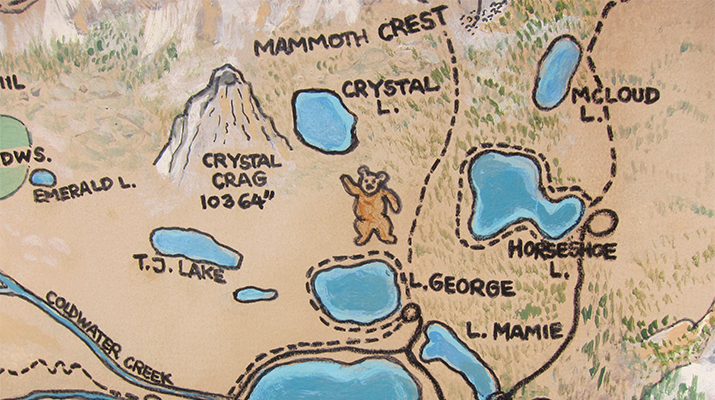California has some of the most glorious natural scenery, not only majestic Yosemite National Park, Lake Tahoe, Big Sur and Point Reyes, but also golden hills dotted with oak trees (Napa and Sonoma Valleys), deserts with cactus and knobby Joshua trees (California deserts), and alpine meadows covered with shooting stars and buttercups, places where there are no roads, only trails through the landscape.
Hiking with kids at any age is a wonderful experience.
Stick your infant in a baby backpack (ditch the stroller), and you can hike as far as you like. With toddlers, savor the experience of stopping to look at every little thing along the way.
The distance may be short, but the joy of tiny discoveries is immeasurable.
Watch curly oak leaves floating in the creek, red ants digging holes on the trail, bees buzzing in a hive stuck on a massive sandstone cliff. Climb in the branches of a live oak tree along the way or spend time playing in a stream.
With older kids, you can cover more territory, hike longer distances to reach a high mountain lake, scramble over rocks in the desert or follow a chalky trail to reach the beach far below.
And before you know it, your kids will be taking the lead, speeding up the trail ahead, leaving slowpoke adults in the dust.
Hiking in California is something we’ve done with our kids since they were infants. One summer when the boys were 3 and 5, we spent several weeks in Reds Meadow, in the Eastern Sierra.
In Reds Meadow Valley, we could hike to a meadow or bubbling spring, then take the shuttle bus back (a free shuttle bus goes down the valley). Other hikes were off the shuttle bus route, but took us to spectacular sights, such as Rainbow Falls.
A most ambitious hike was up the Red Cones, 6 miles round trip, 1,000 ft. gain in elevation.
Our 3 year old was my special hiking partner. I walked hand in hand with him. When he was tired, we rested, but I’d say, “Let’s stop up the trail at that shady spot under that tree,” or “Can you make it to the top of this little hill?”
We had lots of snacks and drinks of water along the way. And before he realized it, we were at the top of the Red Cones.
Some kids are natural hikers, others may ease into it more slowly.
Start easy, but keep at it. With a little effort, the rewards are so satisfying – wade in a river at the bottom of a magnificent waterfall, look out over the panorama of a golden valley below, or climb to a mountain pass, where views in any direction go on, as far as the eye can see.
Tips for enjoying family hikes
- Drinking water – Anywhere you go, bring along bottled water, especially in the desert or at high elevations in the mountains. In the warm, dry California air, it’s easy to get dehydrated. Streams may look clear and pristine, but don’t drink from them, even in the High Sierra.
- Snacks – Bring out kids favorite snacks when you need to take a break, rest a little, then get going again.
- Good foot wear – Make sure everyone has comfortable shoes, even on short hikes. Nobody likes to hike if your feet hurt. Closed toed shoes, with socks, are best. Flip flops and plastic sandals are difficult on dirt paths or trails.
- Sunscreen and hats – California has a wonderfully temperate climate, but don’t be deceived, it’s easy to get sunburned. Wear hats that cover your face and neck, and slather on the sun screen.
- Mosquito repellent – If you’re hiking near streams in the spring and early summer, mosquitoes may be out in force. Bring along mosquito repellent, spray-on stuff suitable for kids.
- Poison oak – One of the most annoying plants, ubiquitous throughout California, from the foothills of the Sierra Nevada to the Pacific Coast, is poison oak. When you brush against the leaves, the oil from the plant irritates the skin, turning into tiny blisters that itch for days. Poison oak loses its leaves in winter, and even the stems can give you a poison oak itch. If kids are hiking in shorts and sandals, watch out for plants growing close to the trail.
- Rattlesnakes – Rattlesnakes live at lower elevations all around California. You can tell a rattlesnake by its triangular shaped head, and also look (and listen) for the rattles on the tail. If you’re climbing up rocks, watch where you put your hands – you don’t want to surprise a rattlesnake sunning itself on a rock. If you see a snake, leave it alone, don’t try to get closer for a better look. Baby rattlesnakes are also to be avoided – they bite too.
- Ticks – Ticks carrying Lyme disease are found in California, in areas such as the Santa Monica Mountains above Malibu, Sonoma Coast and the Napa Valley. These are low risk areas, but after you’ve been out hiking, check for ticks. If you’ve been bit by a tick carrying the bacteria that causes the disease, look for a “bull’s eye rash.”
Also find so many more fun things to do, when you go traveling with kids in 45+ countries worldwide: Travel for Kids

